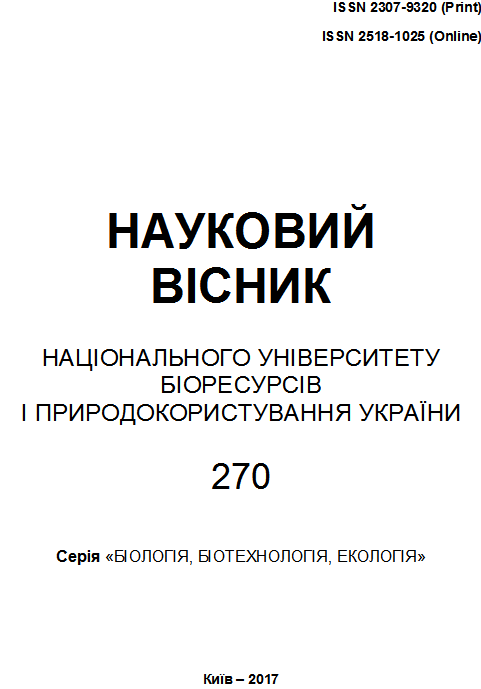ADAPTATION PLANTS REGENERATED ROSE ESSENTIAL OIL TO THE CONDITIONS IN VIVO
Abstract
The optimal conditions and type of substrate have been selected for effective adaptation of clones of essential oil of Lan’ to conditions in vivo. It was established that the best method of adaptation and cultivation of plants before laying plantations is the method of adaptation in a greenhouse for the use of a mixture of peat:perlite (2:1), which contributes to the rapid elongation of clones. Optimum for transfer to conditions in vivo are regenerants with a height of not less than 3.5 cm. The worst period of transfer of plants from in vitro conditions to in vivo conditions is the end of May - the beginning of June, and from the conditions in vivo to ex vitro is the end of July - the beginning of August .References
Dedyukhyna, O.N. (2011). Adaptatsyya rastenyy-rehenerantov k pochvennym uslovyyam. [Adaptation of plants-regenerants to soil conditions]. Vestnyk udmurt•s'koho unyversyteta,pp 31−35.
Zarubyna M.A.,et al (1988). Adaptyvnye reaktsyy kul'turnыkh rastenyy na byotycheskye y abyotycheskye stressy [Adaptive reactions of cultivated plants to biotic and abiotic stresses]. Sel'skokhoz. byolohyya. M.,pp. 111-117.
Kushnir H.P. (2005). Mikroklonalne rozmnozhennia roslyn. [Micropropagation of plants]. K.: Naukova dumka. 273 s.
Lempitskyi L.P. (1958). Kultura troiand u vidkrytomu hrunti.[ Culture roses in the ground]. K.: Vyd-vo AN URSR,123s.
Nazarenko L.H. (1978). Roza efyromaslychnaya.[ Rose essential oil]. K.: Naukova Dumka, 196s.
Nazarenko L.H. et al (1999). Razmnozhenye rozy efyromaslychnoy. [Reproduction of roses of essential oils]. Symferopol',93 s.
Rubtsova O. L. (2009). Rid Rosa L. v Ukraini: henofond, istoriia, napriamy doslidzhen, dosiahnennia ta perspektyvy. [Rosa L. Reed in Ukraine gene pool, history, research areas, achievements and prospects]. Kyiv: 375 s.
Ginova, A., et al (2012) Rosa damascena Mill. − an overview for evaluation of propagation methods. Bulg. J. Agric. Sci, рр. 545-556.
Downloads
Published
Issue
Section
License
Relationship between right holders and users shall be governed by the terms of the license Creative Commons Attribution – non-commercial – Distribution On Same Conditions 4.0 international (CC BY-NC-SA 4.0):https://creativecommons.org/licenses/by-nc-sa/4.0/deed.uk
Authors who publish with this journal agree to the following terms:
- Authors retain copyright and grant the journal right of first publication with the work simultaneously licensed under a Creative Commons Attribution License that allows others to share the work with an acknowledgement of the work's authorship and initial publication in this journal.
- Authors are able to enter into separate, additional contractual arrangements for the non-exclusive distribution of the journal's published version of the work (e.g., post it to an institutional repository or publish it in a book), with an acknowledgement of its initial publication in this journal.
- Authors are permitted and encouraged to post their work online (e.g., in institutional repositories or on their website) prior to and during the submission process, as it can lead to productive exchanges, as well as earlier and greater citation of published work (See The Effect of Open Access).

